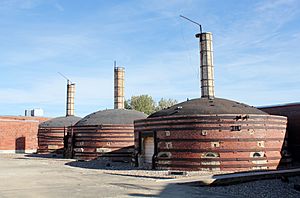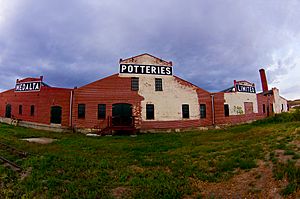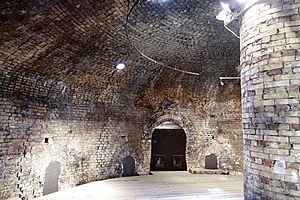Medalta Potteries facts for kids

Brick kilns
|
|
| Private | |
| Industry | Ceramics, china |
| Fate | Bankruptcy |
| Founded | 1916 |
| Defunct | 1954 |
| Headquarters |
Medicine Hat, Alberta
,
Canada
|
The Medalta Potteries was a Canadian company that made ceramic products. It was located in Medicine Hat, Alberta. The company operated from 1916 to 1954. Medalta was special because it was the first factory in Western Canada to send its products all the way to the eastern parts of Canada, past Ontario.
Contents
Why Medicine Hat?
Medicine Hat had many natural resources that helped industries grow. One important resource was natural gas. This gas was used to heat buildings, provide light, and power machines in factories.
Before Medalta, most Canadians bought ceramic items from big companies in the United States. These included Red Wing Stoneware from Minnesota and other potteries from Ohio. In 1916, three partners started Medalta Stoneware with 12 employees. They wanted to show that Canadian-made ceramics could be just as good as those from the U.S.
Medalta's Story
Over time, Medalta's products became very popular. They started to replace American-made ceramics in stores across Western Canada. The factory became famous. Important visitors like Lord Byng, the Duke of Devonshire, and the Prince of Wales came to see it by 1920.
In 1921, Medalta became the first company in Western Canada to ship goods other than grain to Eastern Canada. This created strong competition for Robinson Clay Products, a company from Ohio. Robinson Clay had to lower its prices by 25% to compete.
Changes and Challenges
In 1924, the company changed its name to "Medalta Potteries." At this time, it made 75% of all the stoneware in Canada. This included almost all the stoneware used in Western Canada.
Medalta stopped making red clay flower pots for a while. Instead, they focused on more decorative pots with a creamy glaze. These were very popular. However, a buyer from Eaton's (a big department store) asked them to "make a real flower pot." So, in 1928, Medalta started making red clay pots again. They bought a used machine and dug up red clay from nearby land.
Even with its success, the company didn't make much profit. They often looked for used equipment to save money and expand. Medalta had 82 employees who earned about $3.25 per hour. This was much higher than the labor costs for imported ceramics from countries like England or Japan.
Materials and Shipping
Medalta relied on railways to bring in its raw materials. These materials came from many different places:
- From Ohio: special supports for pottery, wire cloth, and heat-measuring cones.
- From Chicago: wire for pickle jars and a white zinc powder.
- From New York: various chemicals like barium, iron oxide, and manganese.
- From England: sponges.
- From New Brunswick: plaster of Paris.
- From Toronto: ground feldspar.
- From Winnipeg: finely crushed chalk.
- From Deloro, Ontario: black cobalt oxide.
How Medalta Worked
The clay used for making ceramics at Medalta Potteries came from Saskatchewan. The local clay in Medicine Hat was not suitable. Medalta used three types of clay:
- "Chocolate clay" from Chocolate Drop Hill near Eastend. This dark clay turned a lighter color when baked.
- "Saskatchewan Ball Clay" from near Willows. This clay baked white.
- Stoneware clays from Eastend and Ravenscrag.
Medalta often had extra clay. They sold this extra clay to brick makers and schools in Vancouver.
The clay was prepared in the factory, which is now called the Old Factory. The ceramics were shaped in the Turning Room. Medalta made many different products, including:
During the Great Depression in the 1930s, many people traveled across the country looking for work. Medalta's managers allowed these travelers to sleep in the cooling kilns overnight. The kilns could hold up to 40 people. They had to leave before the workday began.
Medalta Today: A Historic Site
Today, the old Medalta factory has been restored. It is now a working museum. In a building next to the site, new pottery items are made. These are replicas of old Medalta pottery and are sold in the museum's gift shop.
The complex also has several art galleries:
- The Collector's Gallery: This gallery is near the kilns and shows the Tony Schlachter Collection.
- The Yuill Family Gallery: This space is for traveling art shows and works by artists who live there.
- The Les Manning Gallery: This gallery is named after a ceramic artist. It is part of the Shaw International Centre for Contemporary Ceramics.
Images for kids




